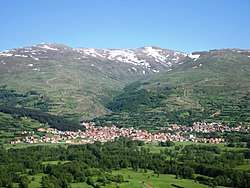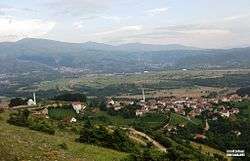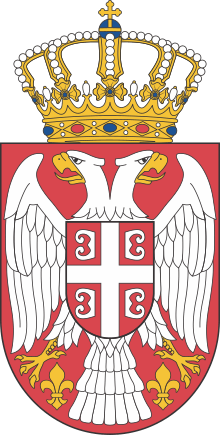Opolje
Opolje (Albanian: Opoja/Opojë, Serbian: Опоље) is a region in the southern part of the municipality of Prizren in southern Kosovo[a]. The region has 19 villages inhabited by Albanians.[1]
Opolje Opoja | |
|---|---|
Geographic region in Kosovo | |
.png) The region and its settlements. | |
| Country | Kosovo |
| District | District of Prizren |
| Municipality | Prizren |
| Largest town | Brodosana |
| Area | |
| • Total | 108 km2 (42 sq mi) |
| Population (1981) | |
| • Total | 18,036 |
| • Density | 170/km2 (430/sq mi) |
Settlements
The region of Opoja includes 19 settlements:
Name
The name Opolje is of Slavic, Serbian origin.[2] According to Milisav Lutovac, the name "had to do with the inhabited localities dotted around a field".[2] The name also appears in Lower Silesia, in Poland - Opole,[2] and in Russia - Opolye.
Geography
Gora, in a collective term, refers to both the Gorani-inhabited Gora (which greater part is in Kosovo, the rest in Albania and Macedonia), and its sub-region Opolje, which is inhabited by Albanians.[3] According to the Serbian Academy of Sciences and Arts (1955), Opolje had an area of ca. 108 km2, while Gora had an area of ca. 500 km2.[3] Sheltered by high mountain ranges of strong and cold winds, Gora and Opolje does not have harsh winters.[4] There is no natural border between Gora and Opolje, while the northern part of the town of Dragaš has been considered part of Opolje as well.
Opolje is one of the traditional župa (county) in the Šar Mountains massif in southern Kosovo, alongside Sredačka Župa, Sirinićka Župa, Gora and Prizrenski Podgor.[5] In the west of Opolje is the region of Lumë, which extends in both Kosovo and Albania.[6]
History
Middle Ages
The villages of Brodosavce, was mentioned in a charter dated 1330, of King Stephen Uroš III. The ruins of the Zinovo fortress is most likely located beneath Brodosavce. There exists ruins of medieval Serbian Orthodox churches and monasteries in Brodosavce, Brut, Plajnik, while old Serbian cemeteries exist in several of the villages.
The Serbian rulers King Stephen Uroš III (in 1326) and Emperor Stephen Dušan (in 1348, 1355) mentioned many of the Opolje and Gora villages in their charters, which shows that they existed before those dates.[2] Opolje was a church estate of the Church of the Holy Theotokos in Prizren throughout the Middle Ages.[7]
The surrounding region possesses a good amount of Aromanian toponyms which Dumbrowski argues show the linguistic situation before Slavification.[8]
Ottoman era
In 1455, the southern territories of the Serbian Despotate were annexed by the Ottomans, and organized into the beylerbeylik of Rumelia. Gora, in its broadest meaning, became a nahiyah of the Sanjak of Prizren.[9] The Ottoman conquest resulted in the old trade routes that linked the Adriatic to the Aegean and Black sea lost their importance because of the insecurity on the roads, and the towns and villages along the roads stopped growing.[9] There are no sources which name Opolje a nahiya in the 15th century.[10]
The Ottoman defter from 1591 registers Gora as inhabited exclusively by Serbs, while Opolje to the north is Albanian populated.[11] In the early 16th century, Opolje and the other Šar župas were governed by Kukli-Bey of Bukhara,[7][12] a period which is marked with the beginning of Islamization of Opolje.[12][13][14] Kukli-Bey was seated in Opolje, and after his death, the local villagers were given the lands, and used the mountains in the outskirts of the villages.[7]
In 1955, Lutovac argued that in the 16th century, the Slavic population of Opolje partially adopted Islam and partially emigrated elsewhere, and the vacancies created by emigration were filled by Albanian incomers.[15] Dumbrowski in 2012 argued that the situation described by Lutovac led to language shift from Slavic to Albanian in Opolje and the surrounding region (but not Gora), and that this is the reason for what Dumbrowski argues is evidence of Slavic substrate effects in the Opoja Albanian dialect.[8] Pulaha in 1984 noted that most Christians in Opolje in 1591 had Albanian names, which Dumbrowski interprets to indicate that at the time Opolje was switching from Slavic to Albanian, what Dumbrowski argues were the Albanian incomers had not yet been fully Islamized.[8]
Modern
In 1913, Sredska, Opolje and Luma were economically tied to Prizren.[16]
From 1945 to [sometime after 1981] Opolje was part of the municipality of Gora, but was then given status of a municipality (due to its Albanian population, as opposed to Gora, which was inhabited by Gorani people). It was abolished on November 3, 1992, under the law of the federal Federal Yugoslav Republic of Serbia, and instead joined into the municipality of Prizren.[1] The Gora municipality and Opoja region remained separated during the Milošević period.[17]
During the Kosovo war (1999), Albanians from Opoja fled to neighbouring Albania in cars, trucks and tractors along with others on foot that following the conflict returned home.[18] After the war, Opoja was merged with Gora to form the municipality of Dragaš by the United Nations Mission (UNMIK) and the new administrative unit has an Albanian majority.[17][18] Located in Gora, the town of Dragash is the regional and municipal centre for both the Opoja and Gora regions of Dragash municipality.[17]
Demographics
The population of Opolje, in 19 localities, is totally homogeneously Albanian. According to the 1981 census, Albanians constituted 99.9% of the Opolje population (18,003 of 18,036). The ethnic homogeneity of Opolje dates from long before, as evident from the 1948, 1953 and 1961 censuses, when 99.8% declared as Albanians. Opolje had an annual population growth in 1961-1971 of 33 per 1,000, and in 1971-1981, 29.8 per 1,000, which represents an enormous relative overpopulation (Albanian population boom); according to estimates for 1991, there were 173 people per 1 square kilometre, and in some villages, up to 250 per 1 square kilometre, all in conditions of scarce natural and economic resources.[19] The majority professes Islam.
| Settlement | ||
|---|---|---|
| Belobrod | 808 | A, 808 (100%) |
| Bljač | 1122 | A, 1122 (100%) |
| Brezna | 1971 | A, 1964 (%); S, 1 (%); M, 6 (%) |
| Brodosavce | 2499 | A, 2499 (100%) |
| Brut | 1095 | A, 1094 (99.9%); O, 1 (0.1%) |
| Buča | 770 | A, 767 (); S, 1 (); M, 1 (); O, 1 () |
| Buzec | 240 | A, 240 (100%) |
| Kapra | 482 | A, 482 (100%) |
| Kosovce | 912 | A, 912 (100%) |
| Kuklibeg | 658 | A, 655; M, 2; O, 1 |
| Kukovce | 1334 | A, 1334 (100%) |
| Plajnik | 528 | A, 528 (100%) |
| Plava | 973 | A, 970; M, 3 |
| Rence | 473 | A, 473 (100%) |
| Šajinovac | 1254 | A, 1252; M, 2 |
| Zaplužje | 1273 | A, 1270; M, 3 |
| Zgatar | 822 | A, 821; M, 1 |
| Zjum Opoljski | 457 | A, 455; M, 2 |
| Zrze | 335 | A, 333; M, 2 |
| Total | ? (%), ? (%) | ? (%), ? (%) |
Gallery
 Brezna
Brezna Brut
Brut
Notes
| a. | ^ Kosovo is the subject of a territorial dispute between the Republic of Kosovo and the Republic of Serbia. The Republic of Kosovo unilaterally declared independence on 17 February 2008, but Serbia continues to claim it as part of its own sovereign territory. The two governments began to normalise relations in 2013, as part of the 2013 Brussels Agreement. Kosovo is currently recognized as an independent state by 97 out of the 193 United Nations member states. In total, 112 UN member states recognized Kosovo at some point, of which 15 later withdrew their recognition. |
References
- Weller, Marc (1999). The crisis in Kosovo 1989-1999. Documents and Analysis Publishing. p. 117. ISBN 9781903033005.CS1 maint: ref=harv (link) "Consequently, the region extending north of Dragas city to Prizren, known as Opoje, which comprises 24,000 Albanians in 19 villages are grafted on to the Municipality of Prizren"
- Radovanovic, p. 8
- Srpska akademija nauka i umetnosti 1955, p. 234
- Srpska akademija nauka i umetnosti 1955, p. 236: "заклоњена високим планинским венцима од јаких и хладних ветрова, ни Гора ни Опоље немају оштру зиму."
- Dedijer 1913, p. 230
- Fejzulla Gjabri (Department of Culture of Albania), Information about the Heroic Epos in the Province of Luma
- Mikic 1988, p. 15: "силни Кукли-бег заузео је Опоље, оредњовековни црквени посед Богородичине цркве у Призрену, где је имао свој дворац. После ње- гове омрти сељаци су постали власници земље и корисници планине у границама села."
- Dumbrowski 2012. Phoneme /o/ in Opoja Albanian: Albanian-Slavic Contact and the Slavic Jers. Journal of Language Contact vol 5 issue 2.
- Бурсаћ 2000, pp. 71-73 (Орхан Драгаш)
- MSC 1988: "Није, међутим, сачуван из XV века (или није засад познат) попис нахија Призрен, Хоча и Опоље, али за њих имамо пописе из друге половине XVI века, тако да из XV и XVI века имамо пописе свих метохијских насељених места."
- TKGM, TD № 55 (412), (Defter sandžaka Prizren iz 1591. godine).
- Radovanovic, p. 11
- Ivanic 1902, p. 19: "Дакле, ни Синан-паша ни Кукли-бег (који је потурчио српску област Опоље код Призрена), нису по- турчили Гору. Она се истурчила много доцније, шта више доцније од свију села у Старој Србији. 3 а о в о турчење су криви — вели Јастребов"
- Srpska akademija nauka i umetnosti. Odbor za onomastiku 1986, p. 95
- Lutovac, Milislav. 1955. "Gora i Opolje: Antropogeografska proučavanja". Srpski etnografski zbornik 35: 229–340. Pages 278-280. Cited in Dumbrowski.
- Dedijer 1913, p. 253: "Испод варошн су плодна Подрима и Подгор, затим ђаковички Хас, који је такође знатним делом упућен на призренску пијацу ; економски су за Призрен привезане и шар^ ске жупе Средска, Опоље и Љума."
- Schmidinger, Thomas (2013). Gora: Slawischsprachige Muslime zwischen Kosovo, Albanien, Mazedonien und Diaspora. Wiener Verlag. p. 65. ISBN 9783944690049.CS1 maint: ref=harv (link)
- Krasniqi, Elife (2016). "Social Change in Relation to Patriarchy after 1999 war in Opoja, Kosovo". In Roth, Klaus; Kartari, Asker (eds.). Culture of Crisis in Southeast Europe, Part I: Crises Related to Migration, Transformation, Politics, Religion, and Labour. LIT Verlag. p. 191. ISBN 9783643907639.CS1 maint: ref=harv (link)
- Radovanovic, p. 13
- 1981 Census, Kosovo (Preliminary)
Sources
- Bursac, Milan (Милан Бурсаћ) (2000). ГОРАНЦИ, МУСЛИМАНИ И ТУРЦИ У ШАРПЛАНИНСКИМ ЖУПАМА СРБИЈЕ: ПРОБЛЕМИ САДАШЊИХ УСЛОВА ЖИВОТА И ОПСТАНКА. Beograd.
- Antonijevic, Dragoslav (Академик Драгослав Антонијевић), Етнички идентитет Горанаца (PDF), pp. 23–29
- Dragas, Orhan (Орхан Драгаш), О Горанцима (PDF), pp. 71–73
- Cvijić, Jovan (1966). Balkansko poluostrvo i južno-slovenske zemlje, Books 1-2 (2 ed.). Zavod za izdavanje udžbenika Socijalističke Republike Srbije.
- Dedijer, Jevto (1913). Nova Srbija: Sa 40 slika u tekstu i kartom Nove Srbije (in Serbian). Štamparija "Dositije Obradović,".
- Ivanic, Ivan (1902). Iz Crkvene Istorije Srba u Turskoj (in Serbian).
- Lutovac, Milisav (Милисав Лутовац) (1955). Gora i Opolje [Гора н Опоље]. Београд: Антропогеографска испитивања (САНУ).
- Mikić, Đorđe (1988). Радован Самарџић (ed.). Društvene i ekonomske prilike kosovskih srba u XIX i početkom XX veka (in Serbian). Belgrade: Srpska akademija nauka i umetnosti.
- Radovanović, Milovan (2008). Kosovo i Metohija: antropogeografske, istorijskogeografske, demografske i geopolitičke osnove (in Serbian). Službeni Glasnik.
- Radovanović, Milovan. ŠAR (SHAR) MOUNTAIN AND ITS ŽUPAS IN SOUTH SERBIA'S KOSOVO-METOHIA REGION (in Serbian).
- Srpska akademija nauka i umetnosti (1955). Srpski etnografski zbornik, Volume 69 (in Serbian). Srpska akademija nauka i umetnosti.
- Srpska akademija nauka i umetnosti. Odbor za onomastiku (1986). Contributions onomatologiques, Volume 7. Srpska akademija nauka i umetnosti.
- Stankovic, Todor (Тодор П. Станковић). Путне белешке по Старој Србији 1871—1898.
- Medunarodni naucni skup "Vuk karadzic i njegovo delo u svome vremenu i danas", Beograd, Novi Sad, Trsic: MSC, 1988 [14–20 September 1987]
External links
- Map of Opolje (Harta e Opojes) on Albanian Wikipedia
Further reading
- Reineck, Janet Susan (1991). The past as refuge: Gender, migration, and ideology among the Kosova Albanians (Ph.D.). University of California.CS1 maint: ref=harv (link) (detailed ethnographic study of the Opoja region)
| Wikimedia Commons has media related to Opolje. |
